Sacredness Generators in the Shadeli Yashruti Sufi Zawiya in Acre
The Sufis represent the mystical stream of Islam, believing in the potential for union with God through a spiritual journey. This journey is guided by a teacher, or Sheikh, and involves spiritual practices like seclusion, recitation, meditation, and rituals known as Zikr, among others. These practices and experiences of the Sacred occur within institutions known as Zawiyas[1]. Each Sufi order establishes its own Zawiyas, which function as centers for spiritual activity and learning.
Besides its Religious role, a Zawiya typically serves as a social center, a hub for learning, almsgiving, and community services, such as providing public kitchens for the needy and accommodation for travellers. Primarily, however, it is a place for Sufi practices and religious activities. Unlike a mosque, a Zawiya is where a Sheikh teaches, Zikr ceremonies are held, and meetings take place. It’s often associated with a particular religious leader (Sheikh) and may contain the tombs or mausoleums of Holy figures. The Zawiya is essentially a blend of a shrine and an active Sufi religious and social center[2].
Many of the Zawiyas are extensive compounds specifically designed to encourage and stimulate inner religious experiences. In some of them, elements that serve as Sacredness Generators were consciously incorporated into the layout, architecture, and art of the place. A good example of this is the Zawiya of the Shadeli Yashruti order in Acre.
There are tens of thousands of Zawiyas throughout the Muslim world. On a deeper level, The Zawiya is a place where one journey ends—a horizontal one—and another begins—a vertical one. In Arabic, Zawiya means “an angle,” which can be seen as the point where these two vectors intersect. The concept of horizontal and vertical journeys is linked to Muhammad’s nocturnal journey, an ultimate mystical experience that symbolizes dying in God to live in God. Ideally and spiritually, the Zawiya represents a transitional space between different dimensions and planes of experience, leading to spiritual ascent. It offers a return to the initial mythical time of connection with God, serving as a place of renewed creation.
The Zawiya in Acre serves as the global center for the Sufi Shadeli Yashruti order, as it houses the tombs of its founders. Established at the end of the 19th century, the order has hundreds of thousands of followers. The current center was rebuilt after its destruction in the War of Independence. Currently, the Zawiya remains closed to the general public, with renovations still ongoing, but it has already become a pilgrimage site for believers in Israel, who report mystical experiences during individual visits. The devotees hold religious and public activities at the Zawiya, particularly the Zikr ceremony.
The complex includes a large hall called “Takiya,” covered by the second-largest dome in Acre, used for meetings and ceremonies. Another grand hall, the “Mashhad,” houses the mausoleums of the founding Sheikhs. The complex also includes the old house of the order’s founder, Sheikh Ali Nur ad-Din Yashruti, the house and divan of al-Hadi Yashruti (third Sheikh of the order), some Crusader halls, and other large rooms and houses. In addition to the buildings, there are expansive courtyards and pillared porticos. Overall, it’s a magnificent and beautiful complex, prepared to welcome the multitudes of pilgrims and visitors whenever it’s opened to the general public.
At the entrance to the Zawiya stands an impressive gate structure, which separates the Sacred from the profane, inscribed with the words “Holy place.” Beyond the gate lies a courtyard where a fountain is planned. To the right of the entrance is the large building of the Takiya (meeting hall), topped with the second-largest dome in Acre (after Al-Jazar Mosque), which is blue in colour and visible on the city’s skyline. Directly in front of the entrance is the imposing Mashhad (the Sheikhs’ mausoleum), the site’s Holy of Holies. Its roof features six white domes above six octagonal tomb buildings, surrounding a vast empty hall. Between the six round domes are two large, octagonal domes made of metal frames with coloured glass, allowing light in four colours to filter through: blue, red, green, and yellow. Surrounding the central building is a portico with marble columns in three colours: red, black, and gray.
The current buildings of the Zawiya complex have largely been renovated or constructed within the last twenty years. This offers us a unique opportunity to observe the planning and construction processes of a charismatic Sacred place, and how Sacredness Generators were incorporated into it. The existing layout of the complex provides insights into how these Generators function. This article will explore both aspects in detail.
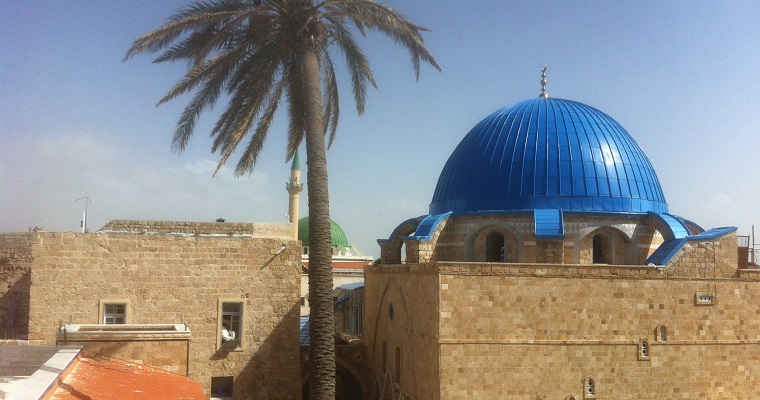
Charismatic planning in the Acre Zawiya
The planning and reconstruction of the Zawiya of the Shadeli order in Acre has occurred over the last twenty years, offering a rare, real-time glimpse into the charismatic planning processes of a Sacred site. Free from conventions and inspired by the Sheikh, the site is recognized as influential among visitors and the general public. Covering five dunams in the heart of Acre’s old city, the Zawiya features restored buildings dating back to the 19th century and newly constructed sections, including the main building. The entire layout, including the large courtyard, reflects a religious vision and is completely up-to-date[3].
The construction of the Zawiya was initiated and inspired by the late Sheikh Dr. Ahmed Yashruti (1928–2020) from Amman, Jordan. He was deeply involved in the planning and construction processes, drawing on his personal connection to Acre, where he was born and lived until he was 18. Sheikh Yashruti wanted the new Zawiya structures to reflect the North African Andalusian style, which resonated with the origins of the order’s founders. Thus, the courtyard was designed with canals and fountains in the style of the Alhambra, and a portico with marble columns and arches was built around the Mashhad
The person responsible for the detailed planning and execution of the work, overseeing the construction, was the order’s previous Matawali, the late Omer Reis from Acre (1958–2019). He was assisted by Hatem Harouf, the current Matawali. Detailed interviews with both of them, along with many years of my own involvement with the project and participation in a planning process meeting that took place in Amman in 2011, provide valuable insights into the planning and execution of the project.
According to Omar Reis, the Zawiya was imbued with symbolic meaning through numbers, colours, symbols, diagrams, geometry, and dimension. This was intended to convey a profound esoteric representation of the spiritual worlds and pathways. Omar had extensive discussions about the Zawiya’s detailed construction with Sheikh Ahmed Yashruti and his son, Dr. Ali Yashruti (who passed away in 2021). The collective deep desire of all three was to create a Sacred place in every sense of the word—a site that would have a positive impact on Acre, Israel, and the wider world, serving as a spiritual lighthouse[4].
The Zawiya building project, led by Omar, aimed to translate the experience of the Sacred into architecture and art, as described by the order’s historian Fatima Yashruti: “The Zawiya is the place of religious ceremonies. A place of prayer, fasting, nights of preservation, contemplation, supplication, meditation, and concentration on God. In the Zawiya, they recite blessings and perform the circles of dhikr, practices in which the fakir disconnects from everything except the glorified God. In the Zawiya, one seeks knowledge and enlightenment. The Zawiya bears witness to and realizes the unity with the glorified and immense God. There, the student immerses in love for God and His messenger”[5]. and “Life in the Zawiya is not like that of dervishes; it is a life of spiritual progress that combines prayer, study, worship, and enlightenment with fulfilling social duties and steadily advancing up the levels of spiritual perfection—the spiritual stations. In the Zawiya, one can achieve a heightened closeness to God[6].
During the planning phase, Omar aimed to connect with divine intelligence, seeking guidance from a form of divine inspiration called “Madad.” This inspiration was believed to emanate from the Sheikh’s spirituality. In the absence of this inspiration, Omar would directly consult with the Sheikh, as his approval was crucial for the plans. According to Omar, divine inspiration represents a kind of Holy spirit derived from a presence known as the light of Muhammad, which the Sheikh embodied. He believed this “Madad” could be transmitted to others involved in the project and encouraged them to share their ideas while always seeking the Sheikh’s approval[7].
The inspiration often emerged through dialogue, a type of discussion known as Mudakara (مُثَاكَرَة). Omar believed that when conducted correctly and with the right sentiment, this practice could bring down the spirit of inspiration (“Madad”) upon the participants, even if the Sheikh wasn’t physically present. Once the believers engage in Mudakara, the Sheikh’s spirit is considered present, potentially revealing itself to them through signs.
While working on the Zawiya plans with others, Omar aimed to foster an atmosphere of discussion and opinion exchange, hoping the unconscious process of Mudakara would bring down the spirit of inspiration (“Madad”) upon the participants. He consistently sought input from others, particularly professionals, allowing space for the “Madad” to emerge from them. His belief was rooted in the idea that each person represents a point on the collective circle of humanity. Thus, every individual has a unique perspective, but as they move toward the center, all these differing viewpoints converge, embodying the essence and goal of Mudakara.
In the planning process, Omar occasionally employed Sufi meditative techniques called Taamul (تَاَمُّل/تَمْل), which he practiced himself. This technique, essentially listening to the signs and what the universe wishes to communicate, involves observing nature while focusing and remaining alert to everything happening, in anticipation of signs. The Sufi remains awake to all occurrences in a state of intense concentration. The Taamul technique connects the person to themselves, not inwardly as in meditation, but through sensory activation and openness to the world. Taamul involves observing and marvelling at the wonders of creation, benefiting the practitioner by enhancing their absorption and attentiveness to the universe’s signs[8].
The inspired planning process led to the intuitive and sometimes conscious incorporation of Sacred characteristics into the building’s architecture and art, such as light, water, and geometric shapes. These elements became Sacredness Generators, embodying Fractal Complexity, Unifying Duality, the Sublime Extraordinary, and the Connecting Center.
The complexity of the place, marked by geometric shapes[9], symbols like a spiritual sun, water, and pillars, creates a cosmology and a sense of order and creation. The beauty, aesthetics, and art awaken a sense of heaven in humans, connecting them to the divine and Sacred part within. This is reflected in the floral and cup decorations (symbolizing divine intoxication) and the exquisite calligraphy. The feeling of sanctity is enhanced by the singing and dhikr ceremonies regularly held in the Zawiya, particularly during the Prophet Muhammad’s birth (Mawlid) and other significant religious events.
During construction, ancient remains were uncovered, including artefacts from the Crusader period, along with water-related elements such as parts of an Ottoman aqueduct and an ancient fountain structure. Many of these were emphasized and highlighted to connect the past with the present. The builders endeavoured to use as many of the ancient stones from the original parts of the Zawiya as possible, allowing the buildings today to convey the mana, the Sacred presence, that existed in the founders’ time.
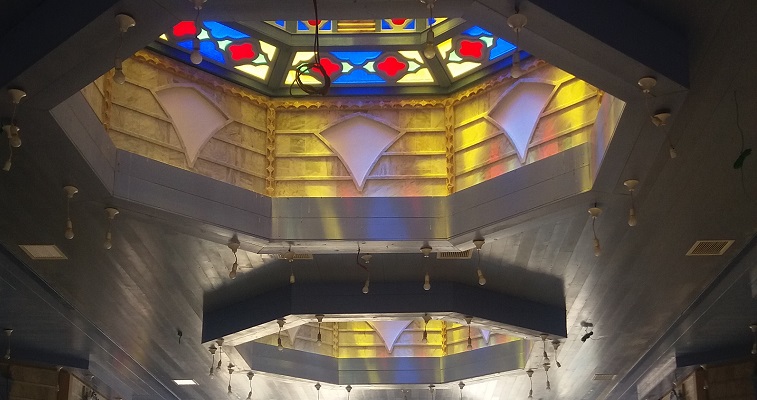
Sacredness Generator Unifying Duality in Acre Zawiya
In the Zawiya of the Sufi Shadeli Yashruti Order in Acre, two Sacred centers exist in separate buildings, yet relate to one another within a single Holy site, creating a Sacredness Generator of Unifying Duality. The large complex features two main buildings: The Mashhad, which houses the Holy graves of the order’s founders, and the Takiya, a space for ceremonies and public activities. The Mashhad represents death and connection to the world beyond, while the Takiya symbolizes life and connection to this world, inspired by the spiritual realms. Despite their differences in form and function, the two buildings are connected in subtle ways that may not be immediately apparent.
The Zawiya serves a dual purpose. On one hand, it’s a place for sanctification and transformation, study, and spiritual development, with the Sheikh representing the axis of Sacredness both in life and death (his grave). On the other hand, it’s a hub for vibrant social activity, aiding the poor, hosting visitors, and promoting study and law[10]. This dual role is reflected in the two main buildings, each dedicated to one of the Zawiya’s functions: The Takiya focuses on social activity, while the Mashhad facilitates connection with the Divine. The Unifying Duality Sacredness generator emerges from the design of the buildings, where similar architectural, geometrical, and mathematical motifs were intentionally incorporated into both. They both employ the same geometric shapes (arch), proportions, modules (measurements), and symbols, thus creating an often unconscious connection between the two structures, which outwardly seem quite different[11]. This connection unites the two activities, which Islam views as part of a cohesive whole.
According to Bennett, Islam faces a challenge in separating the Sacred from the ordinary, or profane, as the religion emphasizes unity[12]. Islam seeks to bring the Sacred into everyday life, so near Holy sites, and often as part of them, you’ll find educational and social service institutions, a form of halal (permissible) activity. The Zawiya thus functions as a place for social services on one hand, and as a space for prayer, solitude, and spiritual journey on the other, following the example of Muhammad’s house, which combined earthly and heavenly activities[13]. This reflects a duality that exists within humans: spiritual and earthly, body and soul.
But there is more to this; in mystical (Sufi) Islam, there is a belief in two divine entities: the primary hidden divinity and the spiritual light entity that emanated from it, forming a secondary divinity called the light of Muhammad, through which the world is created (similar to the Sefirot in the Kabbalah). Therefore, the architecture of the Zawiya reflects this dual aspect of God. The entrance to the Mashhad building is through two large arches, and the ceiling has two octagonal domes with three tiers of coloured glass in four colours—green, blue, red, and yellow—which also appear in the side windows.
The four colours represent the four elements, while the two arches and two domes symbolize God’s dual appearance through His essence and His emanating light. According to the late Omar Rais (who passed away in 2019), the Matawali (endowment overseer) of the order, the double domes and arches symbolize the duality of the hidden divinity (male in essence) and the emanating spiritual light—a creative secondary divinity (female in essence) known as “Nur al-Muhammadiya,” the light of Muhammad[14]. The love relationship between these two divinities sustains the entire world. This relationship exemplifies the Sacredness Generator’s Unifying Duality and illustrates how it functions.
The Mashhad is the Holy of holies, but it is complemented by the Takiya, the second significant structure in the Zawiya. The Takiya is a large square building crowned by a round blue dome, supported by eight arches. The single dome of the Takiya contrasts with the Mashhad’s two domes; it is sealed, unlike the transparent octagonal domes of the Mashhad, yet open to other dimensions. This openness is reflected in the magnificent calligraphic verses engraved on the strip at the base of the dome, where the calligraphy reaches its zenith, and in the beautiful chandelier.
The Takiya is the place for rituals and prayers that aim to provide an experience of the Sacred. In Sufi terminology, it seeks to move a person from a horizontal journey to the beginning of a vertical one. The Takiya is essentially a place of transformation and transition, facilitating a shift from one type of journey to an ascent on the spiritual ladder. This is symbolized by the placement of a large round dome above a square structure, representing the connection between heaven and earth. During the day, the hall is flooded with light from eight coloured windows, and at night, it is illuminated by a huge chandelier hanging from the ceiling.
The Sacred architecture of Muslim Holy sites establishes a connection between heaven and earth by linking the simple, empty floor where people prostrate in prayer (the horizontal vector) and the high, often illuminated dome (the vertical vector). The Takiya hall exemplifies this connection in a beautiful way. This interplay of horizontal and vertical elements, which is associated in Islam with Muhammad’s night journey, Isra’ and Mi’raj, also appears in prayer positions. Worshipers shift from standing and looking upward or toward Mecca to prostrating on the floor and touching it with their foreheads.[15].
The Takiya serves as a space for those who want to pray, perform Zikr ceremonies (remembering God), learn, and engage in social activities and celebrations, making it a place for group activities. In contrast, the Mashhad is the place of the Sheikhs, the “complete human” individuals who serve as a bridge between this world and God, on whose presence the world relies. Spiritually, the Mashhad’s structure holds greater significance, as reflected in the interplay of light and colours entering through the two octagonal ceiling openings, as well as in the symbols and architectural motifs linked to the Garden of Eden. This is where the Sheikhs’ presence is felt. The Mashhad primarily accommodates individual visits, offering opportunities for personal religious experience, but this is complemented by the duality with the social activities in the Takiya
The Sacredness Generator’s Unifying Duality between the two structures teaches us that one cannot exist without the other; there is no path without a teacher, and there is no teacher without students. Once this concept is understood, individuals can transcend themselves, relinquish control, and fully immerse in the holiness of the place.
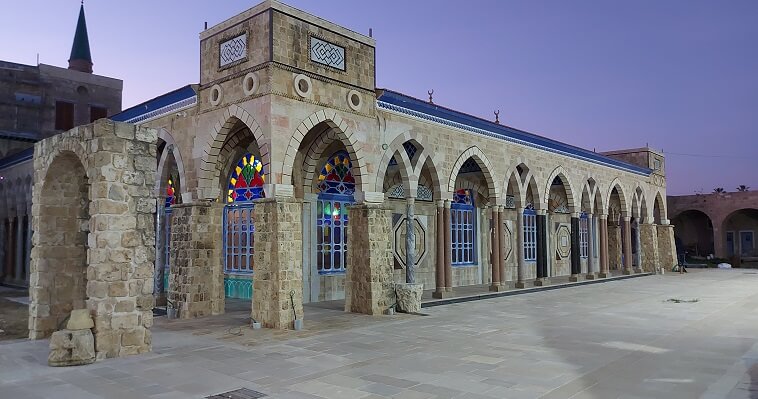
Sacredness Generator Sublime Extraordinary in Acre Zawiya
The extraordinary aspect of the Zawiya in Acre is its remarkable beauty. Its art, architecture, and aesthetic design leave a significant impression on visitors, much like the Bahai Holy sites in Acre or the Dome of the Rock in Jerusalem. In Islam, God has 99 names, half of which relate to beauty and reflect the attributes of the immanent journey. Earthly beauty stirs within us the forgotten memory of divine beauty. The prophet symbolizing beauty is Joseph, to whom an entire Surah in the Quran is dedicated. According to the Sufis, Potiphar’s wife’s infatuation with Joseph’s beauty is seen positively, as it exemplifies what can happen when we encounter the spiritual beauty of the Zawiya. Therefore, In the southern portico of the Mashhad, there are 13 marble columns that, according to Omar, symbolize Joseph, who dreamed of 11 stars, the sun, and the moon bowing to him.
One of the most prominent expressions of beauty, and a Sacredness Generator in itself, is the interplay of colours, especially through the light that filters in from the coloured windows. The light entering the Mashhad hall through the two transparent octagonal domes, with their four colours of stained glass, creates a mesmerizing play of colours and shapes, revealing to us the existence of a world of imagination, images, and archetypes between God the Creator and the physical world. This space connects humans to this intermediary world of emanations through its vast, magical, and awe-inspiring design (similar to Gothic churches), which is enhanced by the light streaming in from the coloured windows on the sides and ceiling. The interior aesthetics, materials, geometry, decorations, symbols, and calligraphy all contribute to this enchanting atmosphere.
Inside the Mashhad lie the graves of the “complete Human””, the founding Sheikhs of the order, who are regarded as the pole of time, the axis of the world, and the link between divinity and the earth, holding the world together. According to Sufi belief, the intermediate world of energies and emanations between God and the world manifests through images involving colours and symbols in our minds (similar to Jungian descriptions of unconscious archetypes). Hence, the multitude of colours and symbols in the Zawiya helps to stimulate our imagination, which in turn can connect us to God.
The Takiya building also features coloured windows, but only in blue and yellow, evoking the colours of the Dome of the Rock and the sun in the sky. The houses adjacent to the Takiya have windows in these colours as well. The dome itself is painted blue on the outside and stands out against Acre’s skyline. This colour is unusual compared to the green domes of the surrounding mosques and is reminiscent of the sky’s dome. However, the Takiya dome is supported from the outside by eight arches, which are decorative rather than architectural. The unique architectural features, such as the blue dome supported by eight arches, the Mashhad’s two transparent octagonal domes, and a freestanding stone gate in front of the Mashhad building without any clear structural purpose, attract our attention. These elements shift visitors’ perception, sharpening their awareness and revealing that there are worlds beyond our own. This opens the possibility of experiencing the Sacred. The Sacredness Generator, the Sublime Extraordinary, appears and functions in this way at the Zawiya in Acre.
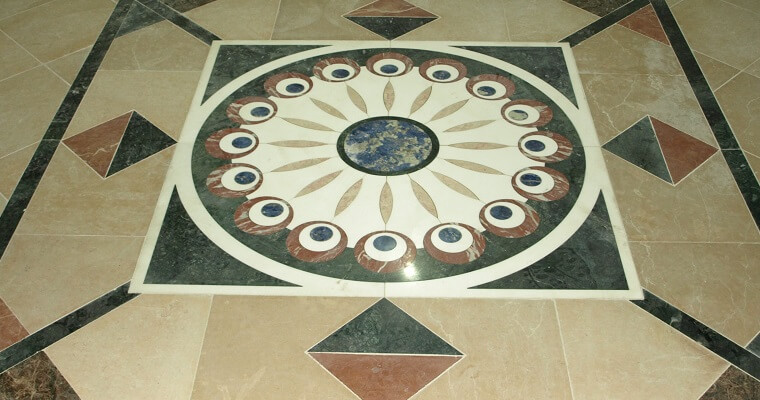
Sacredness Generator Fractal Complexity in Acre Zawiya
One manifestation of the Sacredness Generator’s Fractal Complexity is the splitting of light into colours. These different colours represent various parts of the cosmos that collectively form a unified system, like a rainbow. Being exposed to colours, especially light colours, that interrelate yet are part of one integral whole, activates the Sacredness Generator’s Fractal Complexity in a person. This, in turn, can facilitate an inner religious experience. A good example of this is found in the Zawiya in Acre.
In the central hall of the Zawiya—the Mashhad—four colours appear: red, blue, yellow, and green, radiating through the two transparent domes and the seven windows on the illuminated southern side. These colours form a Cosmology that appears in other Muslim Holy sites, such as the Great Mosque of Al-Jazar in Acre. In Sufi mysticism, these four colours symbolize the four elements from which the world is made: earth, air, water, and fire. The presence of these four colours together creates a world image when understood in context. This is a prime example of the Sacredness Generator’s Fractal Complexity that “lights up” the Mashhad, infusing it with more than just illumination, bringing light, life, and the numinous into it.
The Zawiya in Acre is large and complex, forming a world of its own with intricate interrelationships between its parts (fractal). To fully discover it and reach the Holy of holies, one must navigate its maze and pass through several thresholds, thereby experiencing the Sacredness Generator’s Fractal Complexity.
The Zawiya incorporates many geometric shapes and diagrams, with the octagon, circle, and square being the most common. The octagon is present in the structure of the tombs, in the eight windows beneath the large dome of the ceremonial hall (the Takiya), in the eight arches that support this hall from the outside, and in the mandalas that adorn the walls of the Mashhad. In these mandalas, a square is nested within a circle, which is within an octagon. The significance of the octagon partly comes from a verse in the Quran: “with the angels on its sides. On that Day eight [mighty angels] will bear the Throne of your Lord above them.” (Surah 69: Al Haqqa, The Reality, verse 17). Since the Zawiya is under construction and its builders were interviewed, it is clear that the use of the octagon in the diagrams on the Mashhad walls, in the octagonal glass domes of the Mashhad, in the support arches of the Takiya dome, and elsewhere, was intended to create a world image, a representation of God’s Throne on the surface of the earth.[16]
Be that as it may, the complexity of the place, the prevalence of geometric shapes appearing in mandala-like patterns on the walls and floors (with dozens of mandalas), the archetypal numbers (such as three) that feature in the architecture and art, and the presence of colour schemes all contribute to a cosmology and a sense of order that recurs throughout the complex. In this way, the Sacredness Generator’s Fractal Complexity manifests itself, influencing visitors both consciously and unconsciously.
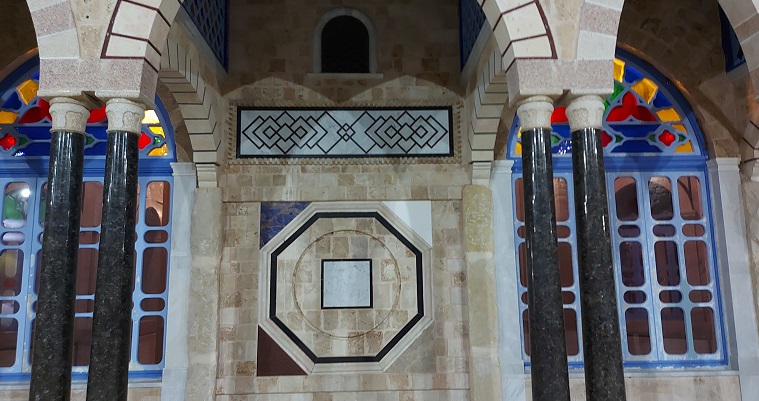
Sacredness Generator Connecting Center in Acre Zawiya
The Sacredness Generator’s Connecting Center is often been linked to the figure of the Tsaddik and his tomb at the heart of the Holy site. In this vein, Fatima Yashruti, the daughter of the order’s founder and its historian, describes the essence of the Zawiya as connected to the role of the Sheikh of the order: “A Holy place and a Holy person are a vertical element within the ordinary. When the Kaaba fell from the sky, it created a hole through which prayers could rise. However, in the case of the Zawiya, as Ibn Arabi, the medieval mystic whose teachings inspired the order, explains, the Kaaba is a man, the pole of the generation, the foundational righteous person of the world. And he is the one who lives and is buried in the Zawiya.” [17] These words precisely portray the complete Human as a Sacredness Generator Connecting Center, a role transferred to his burial place.
The tombs of the Sheikhs, the founders of the Shadeli Yashruti Order, are situated within the Mashhad, the large hall at the center of the compound. There are six octagonal tomb structures, three on each side, with a significant space in the middle[18]. The graves resemble each other; each is housed in a small octagonal mausoleum three meters in diameter, with an arch at the entrance, above which is a circle with Arabic verses. Surrounding the circle are the four names of the “Complete Human,” Insan al-Kamel, the perfect individual through whom the world exists. From the perspective of Shadeli Yashruti followers, the Sheikhs buried in the Zawiya embody the light of Muhammad, the ideal of the perfect Human, the tsaddik upon which the world rests. Thus, the tombs become the world’s axis, linking heaven and earth. They serve as the Sacredness Generator Connecting Center, which is a significant source of the place’s charisma and influential power.
Between the six graves is a large space that naturally connects to the number seven, since it complements the six mausoleums and aligns with the seven large, coloured windows on the southern side, the only side with windows. Above this space are two octagonal stained-glass domes that allow coloured light in four hues—red, blue, yellow, and green—to enter. The large empty space in the middle of the hall directs a person inward, contrasting with the tombs along the sides. The emptiness, the coloured windows, the presence of the Sheikhs, and the beauty of the place suggest the possibility of a spiritual journey up through the seven heavens, as Muhammad did in the night journey. Therefore, the Sacredness Generator Connecting Center is not only the graves but also the empty space in the middle.[19]
In the other prominent structure within the complex, the Takiya, there is a vast empty hall marked by a distinctive ambiance. This space hosts religious public ceremonies that feature, among other rituals, singing and dancing. At the entry to this hall, three arches span the external wall, while inside, a balcony supported by three arches graces the northern interior wall. The external arches are affixed to the wall, whereas the internal arches and columns are freestanding, embodying the individual who has traversed the spiritual path and now stands independently. From the dome’s ceiling dangles a grand, significant chandelier, central to the symbolism of spiritual illumination, encircled by calligraphy featuring the ninety-nine names of God. This grand hall is distinct from a mosque as it lacks a mihrab (prayer alcove); rather than facing outside, it aligns inwardly to the spiritual journey, thus activating a Sacredness Generator Connecting Center.
The dome is closely linked to the archetype of the circle, an element that recurs throughout the complex and represents divine grace descending upon the faithful[20]. Its circular shape symbolizes the principle of Tawahid, the unity of God. This expansive space serves as the Connecting Center, a connection fostered by the rituals conducted within it and maintained through the constant spiritual work taking place. The dome is supported by eight external arches and contains eight blue and yellow stained-glass windows. The number eight signifies the virtuous qualities that one must cultivate to connect with God, embodying the Throne of God (“On that Day eight [mighty angels] will bear the Throne of your Lord”[21]), reaching them brings about the transcendent grace manifested in the ninety-nine names of God, inscribed in calligraphy beneath the windows encircling the dome[22].
The octagon recurs throughout the Zawiya, symbolizing the spiritual person endowed with eight virtues, while the dome represents divine grace. Together, they form the Connecting Center, the world’s axis. This configuration resembles a three-dimensional mandala that unifies opposites—contrasts that reside not outside but within us, representing the id and the super ego, body and spirit, the animalistic and angelic sides present in every individual. Besides the dome with its eight windows, many mandalas are found throughout the site, combining the circle and octagon motifs. This pattern also appears in the architecture of the Dome of the Rock, symbolizing Muhammad’s ascension and, according to Islamic tradition, the world’s creation (the world’s axis).
For the Sufis, the Zawiya represents a place of transformation, where one type of journey ends (horizontal) and another begins (vertical), hence the name “Zawiya,” meaning “Angle.” This idea of a double journey that one must undergo in life is mirrored in the account of Muhammad’s night journey to Jerusalem, which serves as the archetype for the mystical experience of union with God. This is reflected in the architectural motifs of the Dome of the Rock. The journey signifies transcending time and space to connect with eternity and the Sacred within.
The Sacredness Generator Connecting Center embodies both the individual person and the ideal of “Complete Human” represented by the Sheikhs. According to Sufi teachings, humans serve as the true axis that bridges the earthly and the heavenly realms. Through the spiritual journey, individuals can undergo a process of death and rebirth, thereby forging connections between the past and the future, the Sacred and the profane[23]. However, to embark on this journey, one requires a guide—the teacher, who embodies the ideal of complete human, often referred to as the light of Muhammad. Thus, the true essence of the zawiya resides in the Sheikh, the leader of the order, who serves as the pole of the time (generation), through whom the entire world exists[24].
The divine energy present within one Sheikh is transmitted to another, as they are various manifestations of the same essence. Consequently, within the Mashhad, there are six Connecting Centers (tombs), each serving as a world axis where creation undergoes perpetual renewal. The enduring presence of the complete Humans of their time persists in the location where they lived and were interred, sanctifying the place and rendering it a world axis.
In the case of the Zawiya in Acre, the Sacredness Generator Connecting Center found within the tombs of past Sheikhs is further fortified by the fact that the site was constructed under the guidance and inspiration of the current Sheikh of the order, Dr. Ahmed Yashruti. As a descendant of these Sheikhs, Dr. Yashruti is revered by his followers as a living world axis, a pivotal figure of the era. Consequently, everything he undertakes, including the reconstruction of the Zawiya, is imbued with divine grace. Due to his profound connection and attention to the site, the spirit of the Mohammedan light permeates the space in a vivid and potent manner.
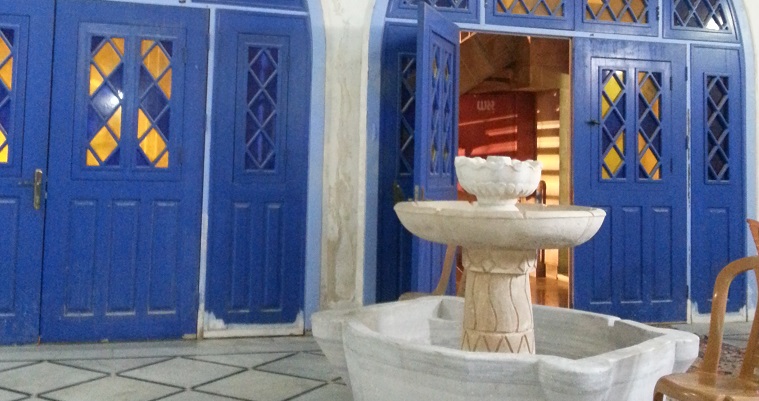
Sacredness Generators in the Zawiya courtyards
The most exemplary instance of integrating Sacredness Generators into the planning of the Zawiya can be observed in the design of its courtyards. Here, designers had the opportunity to commence from scratch, unbound by pre-existing structures. A meticulously crafted courtyard plan was developed by an Israeli landscape architecture firm in collaboration with Omar Rais, drawing inspiration from the Madad and under the supervision and approval of the Sheikhs in Jordan. Although the detailed plan has yet to be implemented, I present it here to illustrate the planning process of a Charismatic Sacred site that incorporates Sacredness Generators within its framework.
The planned courtyard is delineated into three distinct sections:
Firstly, the “Open Garden,” situated at the entrance to the Zawiya, south of the Mashhad and west of the Takia, will feature a spacious square. Within this area, a garden adorned with benches and a striking fountain at its center is envisioned.
The second segment comprises the central boulevard of the Zawiya, extending from the door of the Takia and the southern entrance area to the “hidden” garden and courtyard located at the rear of the Zawiya, leading to the northern entrance of the Mashhad. Along this boulevard, to the east of the marble column portico of the Mashhad, plans include an Alhambra-style flowing water canal and pools designated for pausing and relaxation.
Lastly, the northern section encompasses a sizable square bordered by the Mashhad, three large halls flanking the moat of the old city, and the tower of the Acre prison. Within this expansive, concealed area, a grand plaza with a sizable water pool is envisioned. Adjacent to this pool, below the tower, a verdant garden replete with trees and seating areas will be nestled. Dubbed the “hidden garden,” its concealed nature from the entrance accentuates its significance. Accessible from the plaza, it holds paramount importance as a gateway to the Mashhad.
In this architectural blueprint, the Sacredness Generator Unifying Duality is prominently manifested in the juxtaposition of the visible and the concealed elements, while the Sacredness Generator Fractal Complexity is evident in the subdivision of the courtyard into three distinct parts. Each segment symbolizes different stages in the human journey: The first part, represented by the fountain and courtyard at the entrance, serves as a metaphor for birth—a beginning. The second part, embodied by the boulevard with its flowing water, symbolizes the journey that individuals undertake throughout their lives. Lastly, the plaza, pool, and hidden garden at the rear signify death and the culmination of life’s journey, offering the prospect of human souls returning home to reunite with God.
The fountain positioned at the entrance serves as an embodiment of life’s beginning, symbolizing the process of creation and marking the commencement of the human journey. It signifies not only physical birth but also the transition between dimensions and the spiritual birth. In Sacred Muslim architecture, a fountain holds profound significance as it symbolizes the transition between worlds. The fountain at the Zawiya’s entrance will be elevated above the ground, with water joyfully gushing forth. Adjacent to the fountain, verses from the first revelation of the Quran to Muhammad will be engraved, beginning with the words: “Read, O Prophet, in the Name of your Lord Who created, created humans from a clinging clot. Read! And your Lord is the Most Generous, who taught by the pen, taught humanity what they knew not” (Surah 96: Al-‘Alaq, verses 1-5). To a certain extent, the fountain serves as a Sacredness Generator Connecting Center, symbolizing the Sheikhs interred there and fostering a connection between worlds.
The journey of life is intricately woven throughout the entire garden, exemplifying Fractal Complexity—an intricate pattern of life’s journey reflected within both the garden as a whole and its central part. The journey of life commences at a single point, progresses through various stops along the way, and culminates at another point. This narrative is symbolized by a running water canal adorned with several pools along its path in the middle part (the Boulevard). However, there exists another journey—one of spiritual ascent—that individuals can embark on during their lifetime. This journey is symbolized by the Prophet Muhammad’s nocturnal journey, known as Isra’ and Mi’raj—the horizontal journey leading to the vertical journey. Verses pertaining to this pivotal episode, found in two places in the Quran, will be inscribed at the beginning and end of the flow: “Glory be to the One Who took His servant Muhammad by night from the Sacred Mosque to the Farthest Mosque whose surroundings We have blessed, so that We may show him some of Our signs. Indeed, He alone is the All-Hearing, All-Seeing” (Surah 17: Al Isra, The Night Journey, verse 1), and “And he certainly saw that angel descend a second time, at the Lote Tree of the most extreme limit in the seventh heaven, near which is the Garden of Eternal Residence, while the Lote Tree was overwhelmed with heavenly splendours!” (Surah 53: An-Najm, The Star, verses 13-16). The boulevard is designed to be spacious and shaded with trees for a significant portion of the day, fostering Human gatherings and the flow of life within the space.
In the concealed third part of the garden lies a spacious square, featuring a large shallow pool at its center, surrounded by trees and benches. This pool will serve as a reflective mirror, symbolizing death as both the culmination of life and a new beginning. It will encapsulate all that an individual has done throughout their life, serving as a repository of their experiences and deeds. Adjacent to this pool, the opening surah of the Quran will be inscribed: “In the Name of Allah—the Most Compassionate, Most Merciful. All praise is for Allah—Lord of all worlds, the Most Compassionate, Most Merciful, Master of the Day of Judgment. You ˹alone˺ we worship and You ˹alone˺ we ask for help. Guide us along the Straight Path, the Path of those You have blessed—not those You are displeased with, or those who are astray.” (Surah 1 Al-Fatihah 1-7) offering a profound connection to the divine and serving as a poignant reminder of life’s journey.
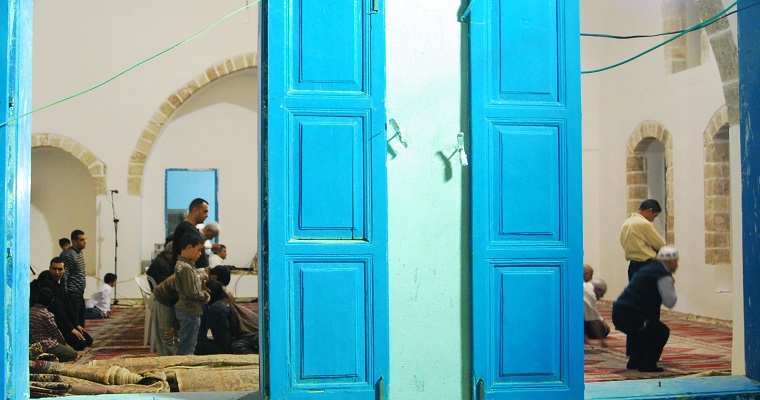
In conclusion
The incorporation of Sacredness Generators Unifying Duality, Sublime Extraordinary, Fractal Complexity, and a Connecting Center into the design of a place can Triger an experience of the Sacred in visitors to it, irrespective of the specific events, individuals interred there, or its cultural and historical significance. These Sacredness Generators have the potential to resonate with individuals on a deep level, transcending differences in background or beliefs. For those who are open and receptive, visiting such a place provides an opportunity for experiencing an inner religious encounter with the Sacred, enriching their spiritual journey and fostering a profound sense of connection.
The Zawiya in Acre stands as a prime example of such a place. Despite its recent construction, it evokes feelings of sanctity and awe not only among the faithful who visit but also among numerous Israelis who frequent the site, even before its official opening. Initially sparking admiration and fascination, the Zawiya gradually fosters interest and appreciation, ultimately prompting individuals to reflect on themselves, life, and even Islam, as well as broader issues they are entangled in. By extracting the impression from the place’s religious and cultural context, one can indeed argue that it fosters an inner religious experience, transcending boundaries and offering a profound spiritual encounter for some of its visitors.
Sufism highlights love as a central aspect of life, a theme supported by both religious studies and the psychology of religion[25]. True religious sentiment is rooted in universality, acceptance, and a sense of interconnectedness among all things, encapsulated by a pervasive and benevolent force, as described by William James[26]. This genuine religious experience stands in contrast to the nationalism, fanaticism, egoism, and animosity towards others that unfortunately characterize some contemporary interpretations of religion, sometimes associated with historical Sacred places. Let us hope that the Zawiya in Acre maintains its universal and inclusive spirit, as envisioned by its founders, serving as a sanctuary for all.
Footnotes
[1] In Persian Zawiya is called Khanqah and in Turkish – Tekke
[2] Itzchak Weismann, “Sufi Brotherhoods in Syria and Israel: A Contemporary Overview”, History of Religions 43 (2004), p. 310
[3] Ben arie, Zeev. Characteristics of Holiness in Holy Places in Israel, Thesis University of Haifa, 2019 P. 99
[4] Ibid
[5] al-Yashrutiyya and al-ʻAlawī, Two Who Attained, p. 121
[6] Ibid p. 122
[7] בן אריה, שניים שהם אחד, עמ’ 36.
[8] בן אריה, שניים שהם אחד, עמ’ 36
[9] The windows with coloured glass were designed according to recurring patterns with symbolic meanings. Similarly, the diagrams and marble mandalas on the walls and floor followed symbolic designs.
[10] Leslie Cadavid (tr.), Two Who Attained: Twentieth-Century Sufi Saints: Fatima al-Yashrutiyya & Shaykh Ahmad al-‘Alawi, Louisville, KY: Fons Vitae, 2005, p. 122
[11] זאב בן אריה, שניים שהם אחד – סיפורו של עומר רייס והזאויה בעכו, יפו: הוצאת פראג, 2021, עמ’ 115.
[12] Bennett, “Islam”, p. 89
[13] Ibid p. 91
[14] בן אריה, שניים שהם אחד, עמ’ 120.
[15] Unlike a mosque, a zawiya lacks a mihrab because the Sufi perspective holds that God is omnipresent.
[16] The question of whether the octagonal pattern contributes to the experience of holiness, similar to the square and the circle, merits its own study.
[17] Sayyida Fatima al-Yashrutiyya and Shaykh Ahmad al-ʻAlawī, Two Who Attained: Twentieth-Century Sufi Saints, tr. Leslie Cadavid, Louisville, KY: Fons Vitae, 2005, p. 121
[18] Three tomb structures are already “occupied,” while three more await their future occupants.
[19] similar to the empty spaces found in traditional Vedic Holy places, as described in the Sthapatya Veda.
[20] Bennett, “Islam”, p. 106
[21] Sura 69, Al-Haqqa, verse 17
[22] בן אריה, שניים שהם אחד, עמ’ 115
[23] שם 113 116
[24] סבירי, הסוּפים, עמ’ 160
[25] Beit-Hallahmi, Benjamin, and Michael Argyle, The Psychology of Religious Behavior, Belief and Experience, London: Routledge, 1997.
[26] ג’יימס, ויליאם, החוויה הדתית לסוגיה: מחקר בטבע האדם, תרגם: יעקב קופליביץ, מהדורה שנייה, ירושלים: מוסד ביאליק. 1959.
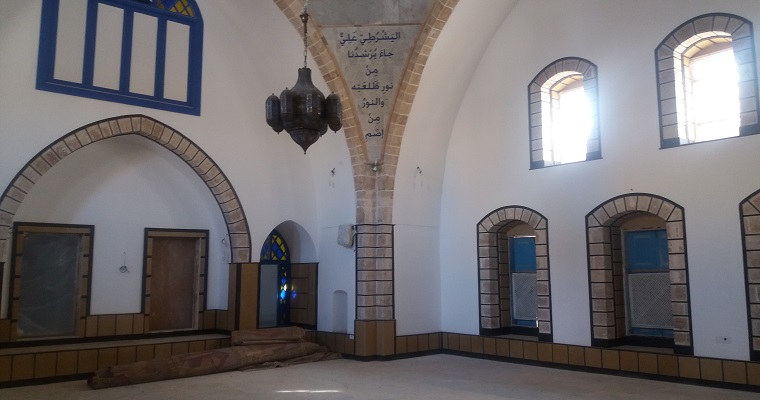
Bibliography
אוטו, רודולף, הקדושה: על הלא־רציונלי באידיאת האל ויחסו לרציונלי, תרגמה: מרים רון, תל־אביב: כרמל, 1999.
אליאדה, מירצ’ה, תבניות בדת השוואתית, תרגם: יותם ראובני, תל־אביב: נמרוד, 2003.
בן אריה, זאב, שניים שהם אחד – סיפורו של עומר רייס והזאווייה בעכו, יפו: הוצאת פראג, 2021.
בן אריה, זאב, מאפייני קדושה במקומות קדושים בישראל, חיבור לשם קבלת התואר מוסמך האוניברסיטה, אוניברסיטת חיפה, 2019.
ג’יימס, ויליאם, החוויה הדתית לסוגיה: מחקר בטבע האדם, תרגם: יעקב קופליביץ, מהדורה שנייה, ירושלים: מוסד ביאליק. 1959.
סבירי, שרה, הסוּפים: אנתולוגיה, תל־אביב: מפה, תשס”ח.
רובין, אורי, הקוראן, תל־אביב: אוניברסיטת תל־אביב ומפה, 2015.
יונג, קרל גוסטב, פסיכולוגיה ודת, תל־אביב: רסלינג, 2005
al-Yashrutiyya, Sayyida Fatima, and Shaykh Ahmad al-ʻAlawī, Two Who Attained: Twentieth-Century Sufi Saints, tr. Leslie Cadavid, Louisville, KY: Fons Vitae, 2005.
Bakhtiar, Laleh, Sufi: Expressions of the Mystic Quest, London: Thames and Hudson, 1976.
Barrie, Thomas, The Sacred In-Between: The Mediating Roles of Architecture, Abingdon: Routledge, 2010.
Beit-Hallahmi, Benjamin, and Michael Argyle, The Psychology of Religious Behavior, Belief and Experience, London: Routledge, 1997.
Ben arie, Zeev. Characteristics of Holiness in Holy Places in Israel, Thesis University of Haifa, 2019
Bennett, Clinton, “Islam”, in Jean Holm and John Bowker (eds.), Sacred Place, London: Continuum, 1998, pp. 88-114.
Eliade, Mircea, The Sacred and The Profane: The Nature of Religion, tr. Willard R. Trask, New York: Harcourt, 1959.
Ittelson, William H., Harold M. Proshansky, Leanne G. Rivlin, and Gary H. Winkel, An Introduction to Environmental Psychology, New York: Holt, Rinehart and Winston, 1974.
Kandinsky, Wassily, Concerning the Spiritual in Art, Bexar County, TX: Bibliotech Press, 2012.
Maslow, Abraham H., Religions, Values, and Peak-Experiences, Columbus, OH: Ohio State University Press, 1964.
Rennie, Bryan S., Reconstructing Eliade: Making Sense of Religion, Albany, NY: State University of New York Press, 1996.
Rosen-Ayalon, Myriam, The Early Islamic Monuments of al-Haram al-Sharif: An Iconographic Study, Jerusalem: The Institute of Archaeology, The Hebrew University of Jerusalem, 1989.
Weismann, Itzchak, “Sufi Brotherhoods in Syria and Israel: A Contemporary Overview”, History of Religions 43 (2004), pp. 303-318.




